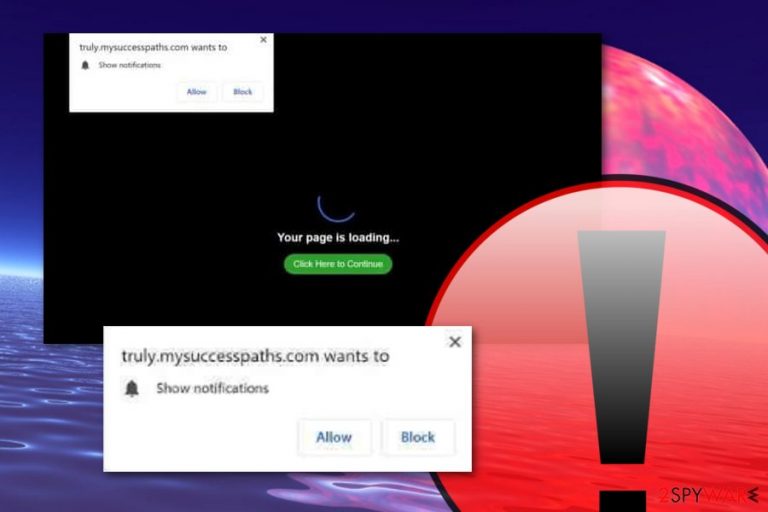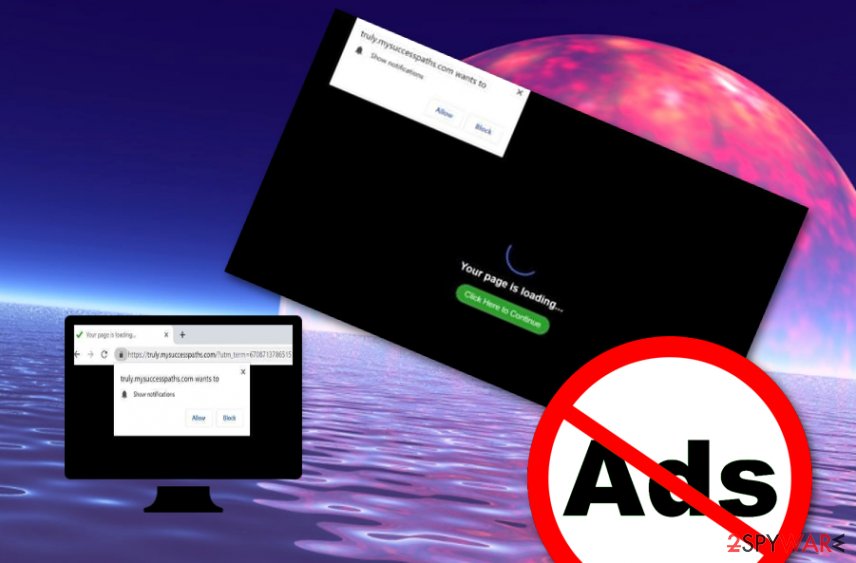Mysuccesspaths.com (Virus Removal Instructions) - Free Guide
Mysuccesspaths.com Removal Guide
What is Mysuccesspaths.com?
Mysuccesspaths.com – adware that has two other related domains, including mi1.mysuccesspaths.com and truly.mysuccesspaths.com

Mysuccesspaths.com is described as an adware program that has more than one advertising domain. This suspicious threat has been detected malicious by two antivirus programs and the results are provided in Virus Total.[1] However, technically this potentially unwanted program is not a virus but some people recognize it as Mysuccesspaths.com virus due to the stealth installation techniques that are used for installation and all annoying activities which are carried out without the user's consent.
| Name | Mysuccesspaths.com |
|---|---|
| Type | Adware |
| Category | PUP |
| Where found | In browser apps and Task Manager, Registry |
| Activities | Advertising, redirecting, non-personal data tracking |
| Other domains | mi1.mysuccesspaths.com, truly.mysuccesspaths.com |
| Removal | Perform the elimination with FortectIntego |
If Mysuccesspaths.com pop-up ads have been bothering you lately, you might experience regular browser and computer struggles as the advertisements might start eating up your system's resources and increasing the CPU power. Once this happens, you will find browser sessions harder and harder to maintain with time.
Notifications on your computer can be pushed not only from Mysuccesspaths.com but also from these two domain names:
-
mi1.mysuccesspaths.com.
-
truly.mysuccesspaths.com.
Talking about these notifications, Mysuccesspaths.com can bring ads in different types of forms to the user's computer desktop. Advertisements can be presented as banners, coupons, pop-ups, pop-unders, and sometimes even highlighted words in texts. The main purpose of these adverts is to gain revenue from the pay-per-click method.[2]
Additionally, Mysuccesspaths.com ads might start providing you with dubious offers of misleading security software, and similar. This way developers seek to swindle your money by convincing you to buy a useless computer repair tool. Be aware of such advertisements as they claim to be provided for the user's needs but they truly are not.
Furthermore, Mysuccesspaths.com redirects can happen through advertising also. This is one of the most annoying activities after the frequent advert flow. Besides, landing on a potentially dangerous website might be very dangerous as there is a risk of infecting your computer system with a dangerous malware form, e.g. Trojan virus.

One more thing that Mysuccesspaths.com might be popular of is data tracking. Mostly, we are talking about non-personal data but still, this activity is promoted for revenue-gaining purposes. Developers track what kind of pages and offers users browser for and generate advertisements that rely on such expectations.
The best thing to do to avoid all of these activities and reverse your browsing quality back to normal is to remove Mysuccesspaths.com from your system entirely. You can do that with FortectIntego or by following step-by-step guidelines that are posted at the end of this article.
These manual Mysuccesspaths.com removal instructions are for cleaning OS and browser apps. Furthermore, you can follow these guidelines to disable the ongoing notification flow that has been caused by the adware:
- Enter your web browser and find the three dots that are located in the upper right corner.
- Choose Settings and then opt for Advanced.
- Under Privacy & Security, select Site settings and open the Notifications list.
- Find and remove Mysuccesspaths.com from the menu. This will help you to block advertising content that is coming from this website.

Bundles freeware/shareware are constantly hiding adware
If you have been downloading third-party software from unrecognizable sources, spotting adware on your computer should not be a surprise to you. These potentially unwanted applications are capable of hiding in bundles of programs and enter the system as an additional product of the bundle.
According to experts from LosVirus.es,[3] the best way to protect yourself from the stealth installation of adware is to opt for the right configuration while downloading/installing a specific program. Our recommendation is to always stick with the Custom or Advanced mode rather than with Recommended or Quick options.
Additionally, the avoidance of third-party networks is another important precautionary measure that you should take if you are keen on protecting your computer system at a higher level. Besides, you can get reputable anti-malware for help while you are completing computing or browsing actions.
Guidance for computer users on the Mysuccesspaths.com removal techniques
Manual Mysuccesspaths.com removal can be carried out with the step-by-step guide that is placed at the end of this article. These instructions will help you to clean Windows and Mac machines and terminate suspicious extensions from browser apps such as Google Chrome, Mozilla Firefox, Internet Explorer, Microsoft Edge, and Safari.
However, if you do not want to waste time on the elimination process of this adware or you do not believe in your skills, you can remove Mysuccesspaths.com from your computer with the help of anti-malware tools. After completing a full system scan and identifying all suspicious content, you will be able to get rid of the cyber threat completely.
You may remove virus damage with a help of FortectIntego. SpyHunter 5Combo Cleaner and Malwarebytes are recommended to detect potentially unwanted programs and viruses with all their files and registry entries that are related to them.
Getting rid of Mysuccesspaths.com. Follow these steps
Uninstall from Windows
You should use these guidelines if you are looking for a way to eliminate suspicious entries and programs from your Windows operating system:
Instructions for Windows 10/8 machines:
- Enter Control Panel into Windows search box and hit Enter or click on the search result.
- Under Programs, select Uninstall a program.

- From the list, find the entry of the suspicious program.
- Right-click on the application and select Uninstall.
- If User Account Control shows up, click Yes.
- Wait till uninstallation process is complete and click OK.

If you are Windows 7/XP user, proceed with the following instructions:
- Click on Windows Start > Control Panel located on the right pane (if you are Windows XP user, click on Add/Remove Programs).
- In Control Panel, select Programs > Uninstall a program.

- Pick the unwanted application by clicking on it once.
- At the top, click Uninstall/Change.
- In the confirmation prompt, pick Yes.
- Click OK once the removal process is finished.
Delete from macOS
Remove items from Applications folder:
- From the menu bar, select Go > Applications.
- In the Applications folder, look for all related entries.
- Click on the app and drag it to Trash (or right-click and pick Move to Trash)

To fully remove an unwanted app, you need to access Application Support, LaunchAgents, and LaunchDaemons folders and delete relevant files:
- Select Go > Go to Folder.
- Enter /Library/Application Support and click Go or press Enter.
- In the Application Support folder, look for any dubious entries and then delete them.
- Now enter /Library/LaunchAgents and /Library/LaunchDaemons folders the same way and terminate all the related .plist files.

Remove from Microsoft Edge
Delete unwanted extensions from MS Edge:
- Select Menu (three horizontal dots at the top-right of the browser window) and pick Extensions.
- From the list, pick the extension and click on the Gear icon.
- Click on Uninstall at the bottom.

Clear cookies and other browser data:
- Click on the Menu (three horizontal dots at the top-right of the browser window) and select Privacy & security.
- Under Clear browsing data, pick Choose what to clear.
- Select everything (apart from passwords, although you might want to include Media licenses as well, if applicable) and click on Clear.

Restore new tab and homepage settings:
- Click the menu icon and choose Settings.
- Then find On startup section.
- Click Disable if you found any suspicious domain.
Reset MS Edge if the above steps did not work:
- Press on Ctrl + Shift + Esc to open Task Manager.
- Click on More details arrow at the bottom of the window.
- Select Details tab.
- Now scroll down and locate every entry with Microsoft Edge name in it. Right-click on each of them and select End Task to stop MS Edge from running.

If this solution failed to help you, you need to use an advanced Edge reset method. Note that you need to backup your data before proceeding.
- Find the following folder on your computer: C:\\Users\\%username%\\AppData\\Local\\Packages\\Microsoft.MicrosoftEdge_8wekyb3d8bbwe.
- Press Ctrl + A on your keyboard to select all folders.
- Right-click on them and pick Delete

- Now right-click on the Start button and pick Windows PowerShell (Admin).
- When the new window opens, copy and paste the following command, and then press Enter:
Get-AppXPackage -AllUsers -Name Microsoft.MicrosoftEdge | Foreach {Add-AppxPackage -DisableDevelopmentMode -Register “$($_.InstallLocation)\\AppXManifest.xml” -Verbose

Instructions for Chromium-based Edge
Delete extensions from MS Edge (Chromium):
- Open Edge and click select Settings > Extensions.
- Delete unwanted extensions by clicking Remove.

Clear cache and site data:
- Click on Menu and go to Settings.
- Select Privacy, search and services.
- Under Clear browsing data, pick Choose what to clear.
- Under Time range, pick All time.
- Select Clear now.

Reset Chromium-based MS Edge:
- Click on Menu and select Settings.
- On the left side, pick Reset settings.
- Select Restore settings to their default values.
- Confirm with Reset.

Remove from Mozilla Firefox (FF)
Terminate all unknown objects from your Mozilla Firefox web browser. If you need some help with the process, use the following instructions:
Remove dangerous extensions:
- Open Mozilla Firefox browser and click on the Menu (three horizontal lines at the top-right of the window).
- Select Add-ons.
- In here, select unwanted plugin and click Remove.

Reset the homepage:
- Click three horizontal lines at the top right corner to open the menu.
- Choose Options.
- Under Home options, enter your preferred site that will open every time you newly open the Mozilla Firefox.
Clear cookies and site data:
- Click Menu and pick Settings.
- Go to Privacy & Security section.
- Scroll down to locate Cookies and Site Data.
- Click on Clear Data…
- Select Cookies and Site Data, as well as Cached Web Content and press Clear.

Reset Mozilla Firefox
If clearing the browser as explained above did not help, reset Mozilla Firefox:
- Open Mozilla Firefox browser and click the Menu.
- Go to Help and then choose Troubleshooting Information.

- Under Give Firefox a tune up section, click on Refresh Firefox…
- Once the pop-up shows up, confirm the action by pressing on Refresh Firefox.

Remove from Google Chrome
If you have found some rogue extensions and other “helper components” in Google Chrome, you should use these instructing steps to get rid of them:
Delete malicious extensions from Google Chrome:
- Open Google Chrome, click on the Menu (three vertical dots at the top-right corner) and select More tools > Extensions.
- In the newly opened window, you will see all the installed extensions. Uninstall all the suspicious plugins that might be related to the unwanted program by clicking Remove.

Clear cache and web data from Chrome:
- Click on Menu and pick Settings.
- Under Privacy and security, select Clear browsing data.
- Select Browsing history, Cookies and other site data, as well as Cached images and files.
- Click Clear data.

Change your homepage:
- Click menu and choose Settings.
- Look for a suspicious site in the On startup section.
- Click on Open a specific or set of pages and click on three dots to find the Remove option.
Reset Google Chrome:
If the previous methods did not help you, reset Google Chrome to eliminate all the unwanted components:
- Click on Menu and select Settings.
- In the Settings, scroll down and click Advanced.
- Scroll down and locate Reset and clean up section.
- Now click Restore settings to their original defaults.
- Confirm with Reset settings.

Delete from Safari
Remove unwanted extensions from Safari:
- Click Safari > Preferences…
- In the new window, pick Extensions.
- Select the unwanted extension and select Uninstall.

Clear cookies and other website data from Safari:
- Click Safari > Clear History…
- From the drop-down menu under Clear, pick all history.
- Confirm with Clear History.

Reset Safari if the above-mentioned steps did not help you:
- Click Safari > Preferences…
- Go to Advanced tab.
- Tick the Show Develop menu in menu bar.
- From the menu bar, click Develop, and then select Empty Caches.

After uninstalling this potentially unwanted program (PUP) and fixing each of your web browsers, we recommend you to scan your PC system with a reputable anti-spyware. This will help you to get rid of Mysuccesspaths.com registry traces and will also identify related parasites or possible malware infections on your computer. For that you can use our top-rated malware remover: FortectIntego, SpyHunter 5Combo Cleaner or Malwarebytes.
How to prevent from getting adware
Stream videos without limitations, no matter where you are
There are multiple parties that could find out almost anything about you by checking your online activity. While this is highly unlikely, advertisers and tech companies are constantly tracking you online. The first step to privacy should be a secure browser that focuses on tracker reduction to a minimum.
Even if you employ a secure browser, you will not be able to access websites that are restricted due to local government laws or other reasons. In other words, you may not be able to stream Disney+ or US-based Netflix in some countries. To bypass these restrictions, you can employ a powerful Private Internet Access VPN, which provides dedicated servers for torrenting and streaming, not slowing you down in the process.
Data backups are important – recover your lost files
Ransomware is one of the biggest threats to personal data. Once it is executed on a machine, it launches a sophisticated encryption algorithm that locks all your files, although it does not destroy them. The most common misconception is that anti-malware software can return files to their previous states. This is not true, however, and data remains locked after the malicious payload is deleted.
While regular data backups are the only secure method to recover your files after a ransomware attack, tools such as Data Recovery Pro can also be effective and restore at least some of your lost data.
- ^ 2 engines detected this URL. Virus Total. Malware detection.
- ^ What is pay per click?. Quora.com. Relevant questions and answers.
- ^ LosVirus.es. LosVirus.es. Spyware news articles.
